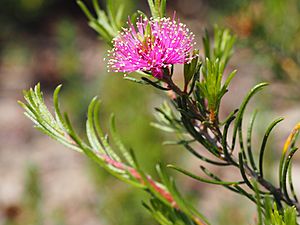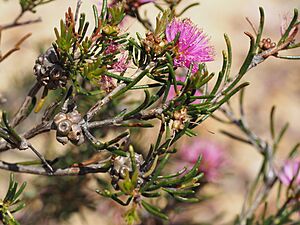Rough honey-myrtle facts for kids
Quick facts for kids Rough honey-myrtle |
|
|---|---|
 |
|
| M. parviceps flowers | |
| Scientific classification | |
| Genus: |
Melaleuca
|
| Species: |
parviceps
|
The Melaleuca parviceps, also known as the rough honey-myrtle, is a type of shrub. It belongs to the myrtle plant family. This plant grows naturally only in the south-west part of Western Australia. It has pretty flowers that can be pink or purple. The tiny tips of the flower parts (called anthers) are yellow.
When John Lindley first described this plant, he said that "every twig ... is terminated by hemispherical heads of brilliant pink." This means each small branch ends with bright pink, round flower clusters. The rough honey-myrtle looks a bit like two other plants: Melaleuca manglesii and Melaleuca seriata.
Contents
What Does It Look Like?
Melaleuca parviceps can grow up to about 1.2 m (4 ft) tall. Its small branches and leaves are covered with soft, silky hairs. The leaves grow one after another along the stem. They are usually 7.5–25 mm (0.3–1 in) long and 0.7–1.2 mm (0.03–0.05 in) wide. Their shape is long and thin, or like a very narrow oval.
Its Amazing Flowers
The flowers grow in round clusters or short spikes. These clusters are found at the ends of the branches. The branches keep growing even after the flowers bloom. Sometimes, flowers also grow where a leaf joins the stem (this is called a leaf axil).
Each flower cluster can be up to 25 mm (1 in) across. Inside, there are usually 2 to 8 groups of three flowers. The petals are small, about 1.7–3 mm (0.07–0.1 in) long. They fall off quickly once the flowers open.
The bright color of the flowers comes from their stamens. These are the parts that hold the pollen. They can be pink, purple, or mauve, with yellow tips. The stamens are grouped into five bundles around the flower. Each bundle has 6 to 10 stamens.
This plant usually flowers in spring and early summer. After flowering, it produces small, woody fruits. These fruits are called capsules and are about 2.5–3.5 mm (0.098–0.14 in) long.
How It Got Its Name
The plant Melaleuca parviceps was first officially described in 1839. This was done by John Lindley in his book, A Sketch of the Vegetation of the Swan River Colony.
The second part of its scientific name, parviceps, comes from two Latin words. "Parvus" means "little," and the ending "-ceps" means "headed." So, "parviceps" means "little-headed." This name was chosen because the first plants found had small flower clusters.
Where Does It Grow?
The rough honey-myrtle grows in the Darling Range area, which is near Perth in Western Australia. It also grows in nearby areas further inland. These areas include the Avon Wheatbelt, Jarrah Forest, and Swan Coastal Plain.
You can find this plant growing in different places. It likes scrubland, heathland, and forests. It often grows in clay or sand that is on top of granite rock.
Is It Safe?
The Western Australian Government's Department of Parks and Wildlife has looked at Melaleuca parviceps. They have decided that it is "not threatened." This means there are enough of these plants in the wild, and they are not in danger of disappearing.
Can You Grow It?
People have successfully grown Melaleuca parviceps in gardens. It grows best in places with good drainage. It also prefers areas with a mild climate and not too much humidity (moisture in the air).
Related pages
- Melaleuca scabra, commonly known as rough honey-myrtle.



